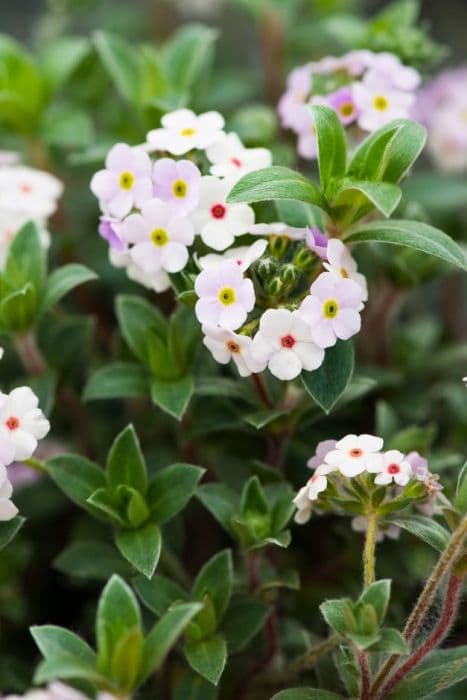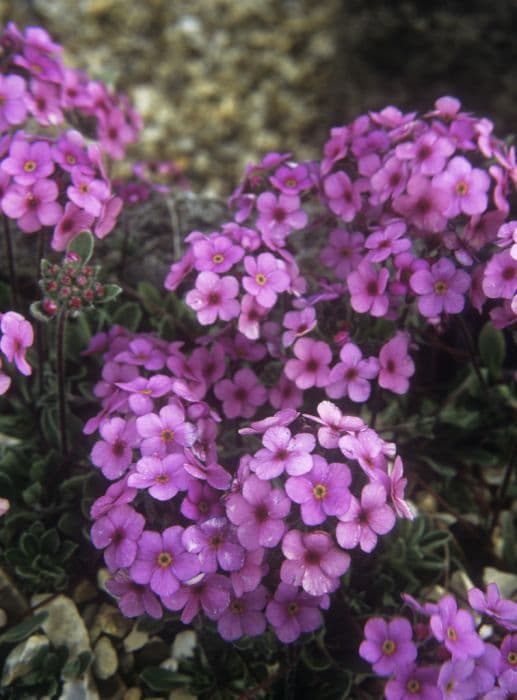Yellow Loosestrife Lysimachia punctata 'Alexander' (v)

ABOUT
The plant known as 'Alexander' is a distinctive variety with a unique appearance. Its foliage is particularly eye-catching, prominently variegated with creamy white edges and streaks against a bright green base. The leaves are lance-shaped, and the variegation adds a striking contrast to the landscape. During the blooming season, 'Alexander' is adorned with clusters of small, cup-shaped yellow flowers that add a cheerful splash of color to the garden. These blooms are a favorite for bees and other pollinators, providing a source of nectar. The flowers are neatly spaced on vertical stems, offering a tiered look amidst the foliage. The overall impression of 'Alexander' is of a lively, light-enhancing plant that can enliven garden borders or create an eye-catching spot when planted in groups. Its variegated leaves provide a prolonged display of color, even when the plant is not in flower, making it a valued addition for sustained visual interest throughout the growing season.
About this plant
 Names
NamesFamily
Primulaceae
Synonyms
Yellow Loosestrife 'Alexander', Dotted Loosestrife 'Alexander', Alexander's Loosestrife
Common names
Lysimachia punctata 'Alexander'
 Toxicity
ToxicityTo humans
The plant commonly known as Yellow Loosestrife is generally not considered highly toxic to humans. However, as with many plants, it is advisable not to ingest parts of the plant as they may cause mild stomach upset or an allergic reaction in some individuals, although significant poisoning or severe symptoms from ingestion are not commonly reported.
To pets
Yellow Loosestrife is not commonly listed as a toxic plant to pets, such as dogs and cats. However, ingestion can potentially lead to mild gastrointestinal upset in some animals, much like in humans. It's always best to prevent pets from eating plants, as individual sensitivity can vary, and some pets might react differently. If a pet exhibits symptoms after ingesting any part of the plant, it is advisable to consult a veterinarian.
 Characteristics
CharacteristicsLife cycle
Perennials
Foliage type
Deciduous
Color of leaves
Variegated
Flower color
Yellow
Height
2 to 3 feet (60-90 cm)
Spread
1 to 2 feet (30-60 cm)
Plant type
Herb
Hardiness zones
4
Native area
Europe
Benefits
 General Benefits
General Benefits- Attracts Pollinators: Lysimachia punctata 'Alexander' or Yellow Loosestrife attracts bees, butterflies, and other beneficial insects to the garden, promoting pollination of surrounding plants.
- Easy to Grow: This plant is known for being hardy and easy to grow, requiring minimal maintenance once established.
- Erosion Control: Its root system can help stabilize soil and control erosion, particularly in areas with damp soil.
- Aesthetic Appeal: With its variegated foliage and bright yellow flowers, Yellow Loosestrife adds color and texture to garden landscapes.
- Landscape Versatility: It can be used in a variety of garden settings, including borders, ponds, and cottage gardens.
- Wildlife Habitat: It provides shelter and food for wildlife, such as small mammals and birds.
 Medical Properties
Medical PropertiesThis plant is not used for medical purposes.
 Air-purifying Qualities
Air-purifying QualitiesThis plant is not specifically known for air purifying qualities.
 Other Uses
Other Uses- Lysimachia punctata 'Alexander,' commonly known as Loosestrife 'Alexander,' can be used as a natural dye source, producing colors in the yellow to brown range depending on the mordant used.
- This plant's stems and leaves can be used in a compost heap, as they decompose well and add nutrients back into the soil.
- The flowers can be used in floral arrangements, providing a soft splash of variegated foliage and yellow color to bouquets.
- It can act as a ground cover in garden designs, effectively suppressing weeds with its dense foliage.
- The plant can be used in marginal water garden settings, being tolerant of damp conditions, it can beautify pond edges without invasive spreading.
- In container gardening, Loosestrife 'Alexander' can be a striking ‘spiller’ element with its trailing habit and variegated leaves.
- When dried, the stems and seed heads of Loosestrife 'Alexander' can be included in dry flower crafts and arrangements.
- The robust nature of Loosestrife 'Alexander' makes it suitable for use in erosion control on slopes or areas with loose soil.
- In butterfly gardens, the plant can serve as a nectar source for pollinators, though it's not the primary choice for butterflies.
- For educational purposes, it can be used to demonstrate variegation in plants, as its leaves show a clear pattern of green and white that can intrigue students of botany.
Interesting Facts
 Feng Shui
Feng ShuiThe Loosestrife is not used in Feng Shui practice.
 Zodiac Sign Compitability
Zodiac Sign CompitabilityThe Loosestrife is not used in astrology practice.
 Plant Symbolism
Plant Symbolism- Perseverance: Lysimachia punctata 'Alexander', commonly known as Loosestrife 'Alexander', is a robust plant that can thrive in a variety of conditions, symbolizing the ability to persist and endure challenges.
- Abundance: With its lush foliage and prolific flowering habit, Loosestrife 'Alexander' represents growth, profusion, and the generous provision of nature.
- Peace: Historically, some species of Loosestrife were believed to soothe and calm, hence, this plant can be associated with tranquility and the calming of strife.
- Life: The vibrant yellow flowers of the Loosestrife 'Alexander' evoke the energy and vivacity of life, often symbolizing vitality and the exuberance of nature.
 Water
WaterAlexander Loosestrife prefers consistently moist soil, so it should be watered thoroughly whenever the top inch of soil feels dry to the touch. In general, this might mean watering approximately once a week, but this can vary depending on climate and weather conditions. During hot or dry spells, the plant may need watering more frequently, perhaps every few days. You should aim to provide the plant with about one gallon of water per watering session to ensure the moisture reaches deep into the root zone. It's important to avoid overwatering, which can lead to root rot, so always check the soil moisture before adding more water.
 Light
LightAlexander Loosestrife thrives in full sun to partial shade. The ideal location for this plant would be a spot where it receives at least six hours of sunlight a day, although it can also perform well with some afternoon shade, especially in hot climates. Avoid placing it in deep shade, as this can result in fewer flowers and a leggy growth habit.
 Temperature
TemperatureAlexander Loosestrife is hardy in USDA zones 4 to 8 and can tolerate temperatures as low as -30°F and as high as 85°F, although it prefers a moderate climate. The ideal temperature range for this plant is between 60°F and 75°F for optimal growth and flowering. Ensure that the plant is protected from extreme heat, as prolonged high temperatures may stress it.
 Pruning
PruningAlexander Loosestrife can be pruned to maintain its shape and to encourage bushier growth. Pruning should be done in early spring before new growth starts. You can cut back the stems by about a third to promote new growth and a more compact form. It's also beneficial to remove any dead or damaged stems at this time to keep the plant healthy. Additionally, after flowering, you can deadhead spent blooms to encourage a second wave of flowers.
 Cleaning
CleaningAs needed
 Soil
SoilThe best soil mix for the Yellow Loosestrife is one that is well-draining and rich in organic matter. The ideal pH for this plant ranges from 6.0 to 7.0, leaning towards a slightly acidic to neutral soil environment. A mix combining garden soil, compost, and some perlite or sand would ensure proper drainage and fertility for the Yellow Loosestrife.
 Repotting
RepottingThe Yellow Loosestrife should ideally be repotted every 2-3 years to replenish its soil and prevent it from becoming root-bound. Repotting also provides an opportunity to divide the plant if it has grown too large.
 Humidity & Misting
Humidity & MistingYellow Loosestrife thrives in average to high humidity conditions; it is not overly sensitive to humidity levels. It generally does well in the humidity levels found in most outdoor garden settings.
 Suitable locations
Suitable locationsIndoor
Use well-draining soil, place in bright indirect light.
Outdoor
Plant in moist, well-draining soil, partial to full sun.
Hardiness zone
3-8 USDA
 Life cycle
Life cycleLysimachia punctata 'Alexander', commonly known as Yellow Loosestrife or Alexander's Yellow Loosestrife, begins its life cycle as a seed which germinates in the spring when temperatures warm. The seedling stage follows, where it establishes a root system and begins to sprout leaves. As it enters the vegetative stage, it develops a clump-forming perennial habit with variegated green and creamy white foliage and rapidly grows to its full foliage size. The reproductive stage occurs in early to mid-summer when Yellow Loosestrife produces spikes of cup-shaped, yellow flowers that attract pollinators. After flowering, it sets seed which disperses nearby, completing the reproductive cycle. During the dormant stage in late fall and winter, the above-ground parts die back, and the plant survives with its underground parts until the next spring.
 Propogation
PropogationPropogation time
Spring to early summer
Lysimachia punctata 'Alexander', also known as yellow loosestrife 'Alexander', is most commonly propagated by division, which is usually done in the spring or fall. To propagate by division, you would carefully lift the clump of the plant from the ground with a spade or fork, ensuring a good amount of roots on each division. Then, using a sharp knife or spade, you'd divide the clump into smaller sections, each with several shoots and a portion of the root system. These divisions should then be replanted at the same depth they were growing at before, and watered thoroughly to establish a good root system. This method is effective as it ensures that the new plants are true to the parent plant, and they often establish quickly, leading to mature plants sooner than other propagation methods such as seed sowing.









